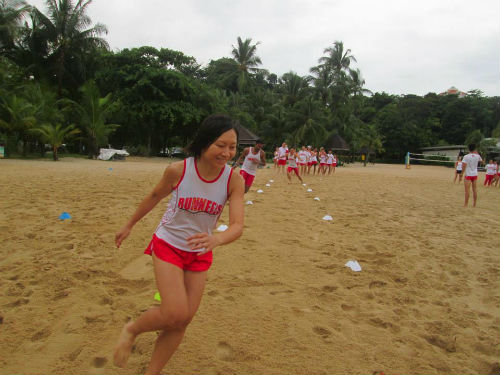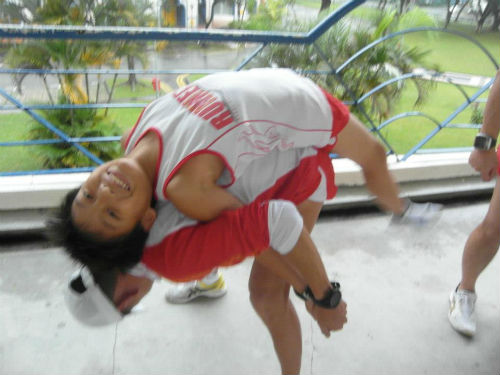Runners who include drills and circuit training exercises into their running routines are likely to have better strength, stamina and endurance – with less injuries. In races, they will consequently perform better too.
I recently caught up with Lexxus Tan, Trainer for F1 Runners Team, to talk to him about running drills and circuit training. The club is known for training runners by sharing tips and providing an ideal training environment – to achieving goals and realising dreams in running.
Here is what Lexxus, 41, said.
What are running drills?
These are basic drills consisting of a sequence of exercises, which should be done regularly – in a very exact and precise manner, – without taking shortcuts.
Runners should include one or two drill sessions into their weekly running programme – to derive maximum benefits from them.
Why are drills necessary?
They develop muscles needed for running, so that the person becomes more efficient in moving. These drills develop automatic ways of moving your muscles properly. So for example, even when a runner is tired, he or she will know how to move efficiently. At the same time, there will be less injuries because the muscles are more developed – to cope better.
What are examples of these exercises?
They include butt kicks (which conditions the glutes and hamstrings and improves your running stride) and high knee lifts (which focuses on driving the foot down and letting it spring back off the ground.
One-leg hops are also done. This is to condition and strengthen your whole lower body (that is, the foot, ankle, shin, calf, thigh and hip areas).
Where should drills be done?
You should be doing it on softer surfaces such as a rubberised track, a field or a flat trail as these will put less pressure on the muscles being exerted.
How long should a drill session last for?
Each drill session should be done for 20 to 40 metres and the whole sequence of exercises should be completed at least once. If you’ve got time, you can repeat the whole drill sequence two or three times. Elite runners will do their drill session ranging from 15min, 30min or 45min – according to their training plans.
What is circuit training?
This is a very intensive form of resistance or weight training for runners to lose weight, gain muscles and increase overall strength.
Essentially, a good circuit-training workout comprises of upper body, core and lower body exercises – to give you an intense, total body workout with little rest in between sets.
Exercises can include push-ups, lunges, sit-ups, burpees and star jumps.
What are the basics of circuit training?
It consists of exercising different body parts by performing multiple exercises – with very little rest in between.
There are two types of circuit training – horizontal and vertical types involving weight bearing exercises.
In the horizontal training, all sets of one exercise are completed before the next exercise is attempted.
For vertical training, a runner does one set of each different exercise, before he or she comes back to the same exercise again.
For weight lifting in circuit training, a person can lift light weights first and progressively work up to doing heavier weights (increasing pyramid) or he or she can start with heavy weights and finish up with lighter ones (decreasing pyramid).
The most important thing to remember when doing circuit training though, is to take very little rest in between the exercises.
What are the benefits of circuit training?
Muscles are developed. Cardiovascular endurance is also enhanced because of the slight elevation of heart rates – which are maintained throughout.
As well, because of the intense nature of the training, large amounts of calories are burnt – good for weight reduction.
In one session, all of the body parts are exercised, so a runner also would not need to devote a different session to exercising other parts of the body.
Any tips to share with runners?
Never copy online training programmes for running. To provide a proper run training programme, an experienced trainer must really understand first, the fitness level of the trainee after a few trial assessments. Only then, can he or she provide a structured training programme with correct training loads to achieving goals and enjoying injury-free running – for the trainee.
If you want to do well in your runs, always get your basic running forms and running techniques right – from the start. Also a training programme should be planned a minimum of six months ahead with all of the races (recommended one race every two month) put in place. If you follow this closely, you will see the difference and run injury-free.
To obtain more information on drills and circuit training you can email Lexxus Tan at f1runnersTeam@gmail.com or call 8175 8677
Other Blog Posts
- What To Expect at sundown marathon 2014
- Marcus Ong’s Tips on Pre and Post Race
- Last Minute Marathon Race Tips
- How to Hydrate for a Running Race
- Secrets of Singapore’s Well Known Runners
- Some of the World’s Toughest Marathons




Leave a Comment